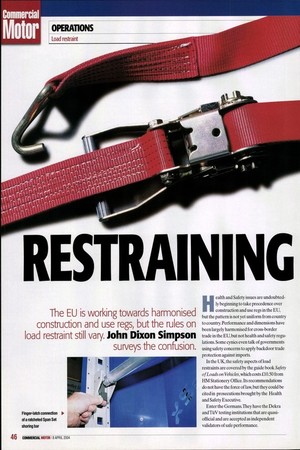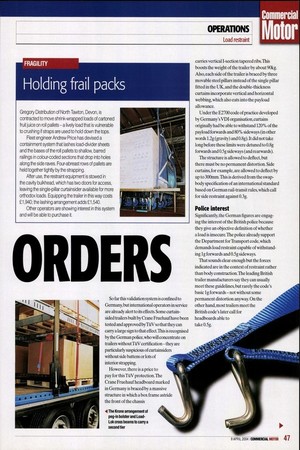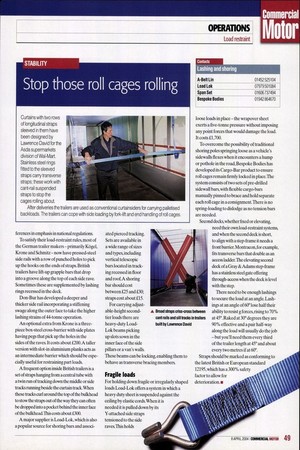ILESITtli N
Page 46

Page 47

Page 48

Page 49

If you've noticed an error in this article please click here to report it so we can fix it.
ORDERS
The EU is working towards harmonised construction and use regs, but the rules on load restraint still vary. John Dixon Simpson
surveys the confusion.
Health and Safety issues are undoubtedly beginning to take precedence over construction and use regs in the EU, but the pattern is not yet uniform from country to country. Performance and dimensions have been largely harmonised for cross-border trade in the EU, but not health and safety regulations. Some cynics even talk of governments using safety concerns to apply backdoor trade protection against imports.
In the UK, the safety aspects of load restraints are covered by the guide book Safety of Loads onVehicles, which costs £10.50 from HM Stationery Office. Its recommendations do not have the force of law, but they could be cited in prosecutions brought by the Health and Safety Executive. Enter the Germans. They have the Dekra and DIV testing institutions that are quasiofficial and are accepted as independent validators of safe performance
So far this validation system is confined to Germany,but international operators in service are already alert to its effects. Some curtainsided trailers built by Crane Fruehauf have been tested and approved by TtiV so that they can carry a large sign to that effect.This is recognised by the German police, who will concentrate on trailers without TiiV certification—they are particularly suspicious of curtainsiders without side battens or lots of interior strapping. However, there is a price to pay for this Ti1V protection. The Crane Fruehauf headboard marked in Germany is braced by a massive structure in which a box frame astride the front of the chassis
carries vertical I-section tapered ribs. This boosts the weight of the trailer by about 90kg. Also, each side of the trailer is braced by three movable steel pillars instead of the single pillar fitted in the UK, and the double-thickness curtains incorporate vertical and horizontal webbing, which also eats into the payload allowance.
Under the E2700 code of practice developed by Germany's VDI organisation, curtains originally had be able to withstand 120% of the payload forwards and 80% sideways (in other words 1.2g (gravity) and 0.8g). It did not take long before these limits were detuned to 0.8g forwards and 0.5g sideways (and rearwards).
The structure is allowed to deflect, but there must be no permanent distortion. Side curtains, for example, are allowed to deflect by up to 300mm.This is derived from the swapbody specification of an international standard based on German rail-transit rules, which call for side restraint against 0.3g. Police interest
Significantly, the German figures are engaging the interest of the British police because they give an objective definition of whether a load is insecure. The police already support the Department for Transport code, which demands load restraint capable of withstanding lg forwards and 0.5g sideways.
That sounds clear enough but the forces indicated are in the context of restraint rather than body construction.The leading British trailer manufacturers say they can usually meet these guidelines, but rarely the code's basic lg forwards — not without some permanent distortion anyway. On the other hand, most trailers meet the British code's later call for headboards able to take 0.5g.
No wonder the police are in favour of a single set of legally enforceable figures.
There has been speculation that the code of practice might be incorporated in planned type approval of bodies and trailers. Not so, says Colin Wilde, in charge of the project at the Society of Motor Manufacturers and Traders. But the design challenge is less severe than might seem because the roof transmits headboard forces back to the rear doorway frame, which is usually a strong, stiff structure. In fact, it has often become integral to the containment of forward forces.
So significant is the contribution of the roof and rear frame that Lawrence David incorporates rubber mountings at the base of the front bulkhead to eliminate the S-shape distortion of a bulkhead that can be generated with a rigid when the trailer chassis bends.This explains why other manufacturers now usually mount the front bulkhead on a channel front crossmember rather than a box, which on the face of it would provide useful torsional stiffness to resist rock of the headboard.
One sentence in the code of practice on curtainsiders advises that curtains should merely be regarded as weather protection, not as load restraints. But it also says:"If the curtains have been designed as a restraint system... the load capability should be clearly marked". Varying strength The load containment abilities of curtains obviously vary, but curtains that incorporate top-to-bottom straps, as originated by Gerald Broadbent with his Boalloy Tautliner, are
well equipped to take side forces.A variant by Lawrence David, firstly with bonded, and later welded, full-height straps has demonstrated impressive load containment ability— not just in a 37° side-tilt test but also in a trial in which a curtainsider with 20 tonnes inside it was craned up sideways.The load did not burst through.And this was in a pillarless curtainsider — which these days accounts for about 75% of Lawrence David's production of some 2,000 a year.
Krone has filmed the movement of an unrestrained load of stacked crates inside a curtainsider while it did 0.4g swerves.The crates shifted and leant on the curtains, but the tension in the curtains pushed the crates back into place when the artic straightened.
But despite such convincing demonstrations of the strength of well designed curtainsiders, officialdom distrusts this type of trailer. On the Continent there is prejudice deriving from past practice that amounts to a culture — curtains hung from tracks are regarded as merely a refined development of covered wagons and TIR tilts.The posts, battens and dropsides remain. There is often sound justification for this because most continental curtainsiders have opening roofs, so they need more pillars. The cant rails are unbraced, making them relatively weak.A curtain, even if strong enough itself, is useless if the roof can't take the strain. Roof stiffness is crucial, too, when the roof carries top-hung lashings.These are convenient so they're common.They are also effective inner restraints to stop loads leaning on the curtain, especially when they are near the centre line of the roof, but this is impossible with an opening roof Consequently, the continental emphasis is
ferences in emphasis in national regulations.
To satisfy their load-restraint rules, most of the German trailer makers —primarily Kogel, Krone and Schmitz — now have pressed-steel side rails with a row of punched holes to pick up the hooks on the ends of straps. British trailers have lift-up grapple bars that drop into a groove along the top of each side rave. Sometimes these are supplemented by lashing rings recessed in the deck.
Don-Bur has developed a deeper and thicker side rail incorporating a stiffening swage along the outer face to take the higher lashing strains of 44-tonne operation.
An optional extra from Krone is a threepiece box-steel cross-barrier with side plates having pegs that pick up the holes in the sides of the raves. It costs about £200.A taller version with slot-in aluminium planks acts as an intermediate barrier which should be especially useful for restraining part loads.
A frequent option inside British trailers is a set of straps hanging from a central tube with a twin run of tracking dovvn the middle or side tracks running beside the curtain track.When these tracks curl around the top of the bulkhead to stow the straps out of the way they can often be dropped into a pocket behind the inner face of the bulkhead.lhis costs about £300. A major supplier is Load-Lok, which is also a popular source for shoring bars and associ
ated pierced tracking. Sets are available in a wide range of sizes and types, including vertical telescopic bars located in tracking recessed in floor and roof. A shoring bar should cost between £25 and £30; straps cost about £15.
For carrying adjustable-height secondtier loads there are heavy-duty LoadLok beams picking up slots sown in the inner face of the side pillars or a van's walls.
These beams can be locking, enabling them to behave as transverse bracing members. Fragile loads For holding down fragile or irregularly shaped loads Load-Lok offers a system in which a heavy duty sheet is suspended against the ceiling by elastic cords. When it is needed it is pulled down by its Y-attached side straps tensioned to the side raves.This holds
loose loads in place — the wrapover sheet exerts a five-tonne pressure without imposing any point forces that would damage the load. It costs £1,700.
To overcome the possibility of traditional shoring poles springing loose as a vehicle's sidewalls flexes when it encounters a hump or pothole in the road, Bespoke Bodies has developed its Cargo-Bar product to ensure roll cages remain firmly locked in place.The system consists of two sets of pre-drilled sidewall bars, with flexible cargo-bars manually pinned to brace and hold separate each roll cage in a consignment.There is no spring-loading to dislodge as no tension bars are needed. Second decks, whether fixed or elevating,
need their own load-restraint systems, and when the second deck is short, to align with a step-frame it needs a front barrier. Montracon,for example, fits transverse bars that double as an access ladder.The elevating second deck of a Gray &Adams step-frame has a stainless steel gate offering through-access when the deck is level with the step. There need to be enough lashings to secure the load at an angle. Lashings at an angle of 60° lose half their ability to resist g forces, rising to 70% at 45°. Raked at 30° degrees they are 90% effective and a pair half-way along the load will usually do the job —but you'll need them every third
of the trailer length at 45° and about every two metres if at 60°. Straps should be marked as conforming to the latest British or European standard 12195, which has a 300% safety factor to allow for deterioration. is
Holding frail packs
Gregory Distribution of North Tawton, Devon, is contracted to move shrink-wrapped loads of cartoned fruit juice on roll pallets — a lively load that is vulnerable to crushing if straps are used to hold down the tops.
Fleet engineer Andrew Price has devised a containment system that lashes load-divider sheets and the bases of the roll pallets to shallow, barred railings in colour-coded sections that drop into holes along the side raves. Four-abreast rows of pallets are held together tightly by the strapping.
After use, the restraint equipment is stowed in the cavity bulkhead, which has two doors for access, leaving the single-pillar curtainsider available for more orthodox loads. Equipping the trailer in this way costs £1,940; the lashing arrangement adds £1,540.
Other operators are showing interest in this system and will be able to purchase it. Tall order
Christian Salvesen has specified largevolume curtainsiders from Don-Bur for its automotive parts distribution operation.
The 4.92m-tall trailers have a fulllength second deck supported on lock-in cross beams. Between the side pillars are slotted, pierced steel channels to which straps are hooked. There are no pillars down the inside to interfere with loading.
The stacks of wheeled cages almost reach the trailer's ceiling, so to ease loading without risk of damage the rear end of the roof can be jacked through a gearset at the bottom to give 300mm extra clearance. The roof rails are slim enough to deflect while the back of the roof is raised.
A safety harness runs in a track under the roof to protect operatives from falling.
The chassis is only 890mm high, so the interior headroom can take cages up to 2m tall. Stop those roll cages rolling
Curtains with two rows of longitudinal longitudinal straps sleeved in them have been designed by Lawrence David for the Asda supermarkets division of Wal-Mart. Stainless steel rings fitted to the sleeved straps carry transverse straps; these work with cant-rail suspended straps to stop the cages rolling about.
After deliveries the trailers are used as conventional curtainsiders for carrying palletised backloads. The trailers can cope with side loading by fork-lift and end handling of roll cages.






































































































